Last Updated on March 5, 2025 by Owen McGab Enaohwo

Operational excellence as a business concept has been around for some time. Every organization wants to create operational excellence that allows them to continuously meet customers’ needs and position themselves as stand-out brands. However, many organizations do not know exactly how to go about it, mainly because there is a lot of contrasting information (online) about this concept, making it difficult to appreciate its meaning and how to achieve it.
This guide will show you everything you need to know about operational excellence. First, we’ll help you understand what operational excellence really is. Then, we’ll show you examples of how other companies have achieved it and how you can implement and achieve it for yourself.
Before diving in, take a few minutes to claim your 14-day trial on SweetProcess!
Creating an account on SweetProcess is FREE (no credit card required), and will help you set up your first processes in minutes, following the step-by-step instructions in this guide. That’s all you need to start seeing outstanding results in your pursuit of operational excellence.
Operational Excellence Full Guide – Table of Contents
What Is Operational Excellence?
Benefits of Operational Excellence in an Organization
10 Core Principles of Operational Excellence
How to Achieve Operational Excellence in Your Company: Tips and Best Practices
How to Achieve Consistency in Your Company’s Operations Using SweetProcess
Top Operational Excellence Methodologies
Operational Excellence Examples From Which You Can Learn
How to Measure Operational Excellence in Your Company
How Operational Excellence Differs From Other Operations Frameworks
Achieve Consistency in Your Company’s Operations Using SweetProcess
What Is Operational Excellence?

There is no single definition for operational excellence. Experts have defined operational excellence in several ways based on their perceptions.
The Institute for Operational Excellence defines operational excellence as a situation where every employee can see the flow of value to the customer and fix it before it breaks down.
According to the Operational Excellence Society, operational excellence is when the organization’s efforts are aligned to achieve its strategies and where the corporate culture is committed to the continuous and deliberate improvement of company performance and the circumstances of those who work there.
Additionally, IBM defines operational excellence as an approach to business management that emphasizes continuous improvement across all aspects of the business and within all business processes by creating a culture where management and employees are invested in business outcomes and empowered to implement change.
These definitions of operational excellence all focus on continuous improvement, where every employee plays an active role in understanding and improving the flow of value to customers. This involves aligning organizational efforts, fostering a culture of deliberate process improvement, and empowering employees to contribute to enhancing business processes and outcomes.
Daniel Delank, COO of Loadbee, explains that having the right mindset is the key to achieving operational excellence. This implies that with the right attitude and approach toward continuous improvement, every individual within the organization becomes an integral contributor to refining processes, which will ensure outstanding value delivery.
Benefits of Operational Excellence in an Organization

Operational excellence, when integrated into an organization’s framework, yields numerous invaluable benefits, some of which are highlighted below.
1. Enhanced Customer Satisfaction
Operational excellence ensures that every interaction with customers is efficient and consistent. When customers receive products or services on time, experience fewer errors or delays, and find consistent quality, it naturally results in higher satisfaction. There is no gainsaying that positive experiences increase customer loyalty, bring about repeat business, and create a positive brand image.
2. Improved Product Quality
Operational excellence involves stringent quality control measures throughout the production process. Organizations deliver products that meet or surpass customer expectations by reducing errors, ensuring consistency, and maintaining high standards. This dedication to quality builds brand trust and credibility. Companies like Apple have set new standards by consistently delivering top-notch products that consumers appreciate, improving their brand reputation and loyalty.
3. Increased Productivity
Efficiency in operations leads to increased productivity. By implementing lean process improvement, businesses can streamline workflows, eliminate waste, and refine processes to maximize output. This approach ensures that every step adds value, allowing organizations to achieve more with fewer resources—ultimately boosting their bottom line.
4. Culture of Continuous Improvement
Operational excellence instills a culture where employees are encouraged to identify inefficiencies and suggest improvements. Developing this mindset leads to innovation, problem-solving, and adaptability, which enhances processes and improves performance. General Electric’s adoption of Six Sigma principles exemplifies this. They’ve created a culture where employees engage in continuous improvement efforts, which improves operational efficiency and performance at all levels.
5. Faster Response to Market Changes
Agile operations enable companies to swiftly adjust strategies, products, or services in response to market shifts or customer demands. Businesses that can adapt their operations quickly can take advantage of new trends, grab opportunities, and maintain a competitive edge. Agile methodologies embraced by tech companies like Spotify enable rapid adaptation to market shifts. This flexibility allows for quicker product iterations and responses to customer demands.
6. Differentiation from Competitors
Operational excellence becomes a unique selling point. Companies that consistently deliver better products, services, or experiences due to efficient operations stand out in the market. When a product or service is known for being reliable and providing excellent features, it attracts more customers. This gives the business an edge over its competitors as people prefer to use dependable things that offer great value.
7. Higher Employee Satisfaction and Retention
Creating a well-organized system at work can make employees feel more involved. This can be achieved by valuing employees’ ideas, developing standard operating procedures, and setting realistic expectations. Employees who feel connected to their workplace are more likely to stick around for the long haul. This helps create a positive work environment. The cost of hiring and training new staff is reduced as the existing workforce stays.
10 Core Principles of Operational Excellence

Operational excellence is crucial to ensure success in any business. This concept requires establishing a solid foundation by organizing and streamlining business processes. One of the basic operational excellence principles is prioritizing customer satisfaction and continually striving for improvement. In this next section, we outline some essential principles crucial for achieving operational excellence.
1. Customer Focus
Businesses need to focus on what their customers want. Keeping your customers happy and loyal is essential by listening to their needs and expectations. This means giving them good value and great experiences. When companies do this, they build strong relationships with customers who will come back again and again.
2. Continuous Improvement
Improving how things work is a never-ending process. To improve things, we constantly seek ways to do tasks smarter, cutting out what’s not needed and ensuring everything flows seamlessly. Getting everyone involved and welcoming their ideas is crucial. This way, we can keep improving things over time.
3. Process Standardization
Process standardization is a way of doing things consistently and reliably. It helps businesses work more efficiently and effectively by reducing differences in the results that people get when doing the same task. By following a standard operational process, we can ensure that everyone is doing things the right way, and we can identify and fix problems more efficiently.
4. Employee Empowerment and Engagement
When employees have the agency to make their own choices and take control of their work, it helps them feel like they are in charge and accountable for their actions. Employees who are engaged at work are more likely to put in their best efforts and take part in improving the way things are done.
5. Data-Driven Decision-Making
Making good decisions and improving operations can be challenging for organizations. Data can be beneficial in such situations. When a company collects and studies essential information, it can find out what needs to be improved, measure progress, and make decisions based on facts instead of just guessing.
6. Agility and Flexibility
Business methods are constantly evolving, and being excellent at what you do means being able to adapt quickly and smoothly. When things like the market, new technology, or customer preferences change, it’s crucial to respond swiftly. That’s how businesses stay ahead of one another and achieve success.
7. Process Visibility and Transparency
Clearly seeing how things work is critical to getting great results. When everyone involved in a project has real-time information, it makes collaboration easier, ensures accountability, and helps understand how each task contributes to the primary goal. This enhanced visibility helps to improve teamwork and achieve project success.
8. Lean Thinking
Lean thinking is a way of doing things that simplifies processes and cuts down on waste. The idea is to focus on providing the most value with the least resources by getting rid of anything unnecessary or that causes delays. This approach guarantees enhanced employee productivity and effectiveness for organizations to reach their goals.
9. Continuous Learning and Training
It’s crucial to help employees keep learning and provide them with training that is useful for their jobs. By adopting this method, people can improve their skills and knowledge, which can make them more skilled and efficient in their work. When everyone is learning and growing, it can help the overall process and make things run smoother.
10. Leadership Commitment and Support
Effective leaders are crucial for any organization to function smoothly. They inspire and guide their teams to strive for business excellence and encourage them to improve continuously. By actively participating in improvement initiatives, leaders set an example for their team members and show the importance of progress and growth for the entire organization.
How to Achieve Operational Excellence in Your Company: Tips and Best Practices

For a successful operational excellence plan in your company, there are certain things you must put in place and values you must imbibe. Here are six priceless tips and best practices to achieve operational excellence in your organization.
1. Have a Clear Vision
When making significant changes in a company, begin with a clear vision. This vision could be about the product, growth, market share, or something similar. Make sure everyone—leaders and team members—knows this vision well. This way, everyone can collaborate, take calculated risks, make informed decisions, and work toward common goals.
Think of this as having a clear map or plan for where you want your company to go. It’s like everyone is on the same page about the exciting adventure ahead. When everyone knows the direction, they can all work together to get there.
2. Use the Right Tools
Operational excellence starts by employing the perfect tools for each task. Having the right tools makes the job easier and faster. Just as a carpenter relies on top-notch tools to build a robust house, your company thrives with suitable software, machinery, or methods. These tools act like magic ingredients, streamlining work and accelerating success.
Similar to following a recipe, using the right change management tools in the right way simplifies tasks, much like having the ideal equipment—be it software, machines, or methods—that ensures your company runs seamlessly and efficiently.
Some of the tools for achieving operational excellence are process mapping, IT-business team alignment, no-code software, and automation.
3. Teamwork Matters
In a company, when everyone helps out and collaborates, amazing things happen! Getting the time and resources for a company-wide operational excellence strategy is more straightforward when everyone is on the same page. From top-level executives to junior employees, everyone must understand how operational excellence helps both them and the whole company.
4. Learn From Mistakes
A critical aspect of running a successful business is knowing how to handle mistakes. This is particularly important if you want to achieve operational excellence. Mistakes are like slip-ups that mess up the smooth flow of things, often leading to faulty products and causing waste.
Therefore, when a mistake happens, it is essential to pause and fix it before moving on. It’s like fixing a small hole in a boat before sailing. Addressing these errors keeps your process in shape, ensuring things run smoothly.
5. Repeat What Works
Finding a winning formula can be a game-changer for any company. When you find a way of doing things that work really well, you create a step-by-step guide so that it can be done that way every time. It’s like having a favorite recipe—when you find the right mix of steps that get things done smoothly, keep using it.
Creating repeatable processes in your company ensures consistency and success. By locking in these proven methods, your team can skip the guesswork and confidently follow the tried-and-true path toward operational excellence.
6. Keep Track of Progress
Monitoring progress is a powerful method to lead your company toward achieving operational excellence. By keeping track of milestones and accomplishments, you can gain valuable insights that can be used to improve your business operations.
Whether it is meeting goals or refining plans, tracking progress can enhance efficiency and boost morale. That’s because keeping tabs on progress helps to identify areas for improvement, showcasing how much you have achieved and where you can improve, thus fostering a culture of continuous growth.
If you want to achieve operational excellence in your business, there’s no better tool than SweetProcess. With our help, you can streamline your operations and take your business to the next level. Don’t wait any longer—claim your free 14-day trial now and see the results for yourself!
How to Achieve Consistency in Your Company’s Operations Using SweetProcess
SweetProcess is a robust platform that can help you achieve business consistency. With SweetProcess, you can document procedures, assign tasks, track progress, manage policies, and turn existing processes into a comprehensive knowledge base. Let’s look at some of the standout features you can leverage to achieve outstanding results and drive success.
How to Document Procedures and Processes Using SweetProcess
1. Documenting a Procedure With SweetProcess
Step 1: Click on the “Procedures” tab.
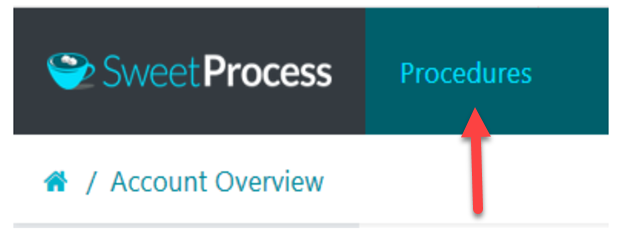
Step 2: Once the page opens up, click on the “Create Procedure” button on the top right-hand side of the page.

Step 3: Enter the title of the procedure.

Step 4: Add the procedure to a team or multiple teams. Then click on a checkbox to add the procedure to a team or on multiple checkboxes to add the procedure to multiple teams at the same time.

Step 5: Click on the “Continue” button.

Step 6: Click on the title of the procedure to add a description.

Step 7: Click on the “Add a Step” button.

Step 8: Give the step a title and description.

Step 9: Attach files and images and embed videos to this step as needed.
Step 10: Click on “Finished Editing” to save the draft of the step.

Step 11: Click the “Add a Step” button to add a new step. Repeat steps 7, 8, 9, and 10 to enter and save the details of the new step.
Step 12: Repeat step 11 until you have added all the steps you need to document the procedure.
Step 13: As soon as you are done with documenting all the steps of the procedure, click on “Approve,” which is on the top right-hand corner of the page, to approve the procedure and make it live.

Note: If you cannot approve the procedure, you may request approval by clicking on the “Request Approval” button as shown below.

2. Documenting a Process With SweetProcess
Documenting processes with SweetProcess offers the advantage of quicker and more straightforward steps compared to other process management tools. Moreover, SweetProcess boasts an intuitive interface, making it accessible even to beginners, who can easily navigate the software with minimal assistance. Now let’s see SweetProcess in action.
Step 1: Click on “Processes” on the top navigation bar.

Step 2: Once the page opens, click on the “Create Process” button in the top-right corner of the page. Alternatively, you can click on the “Create a Process” button in the middle of the page.

Step 3: Enter the title in the space marked “Process Title.”

Step 4: If you’re creating a process for the first time, you must create a new team. To do this, click on “Add to Teams.”

Step 5: Click on “Create Team.”

Step 6: Name your team and click “Create Team.”
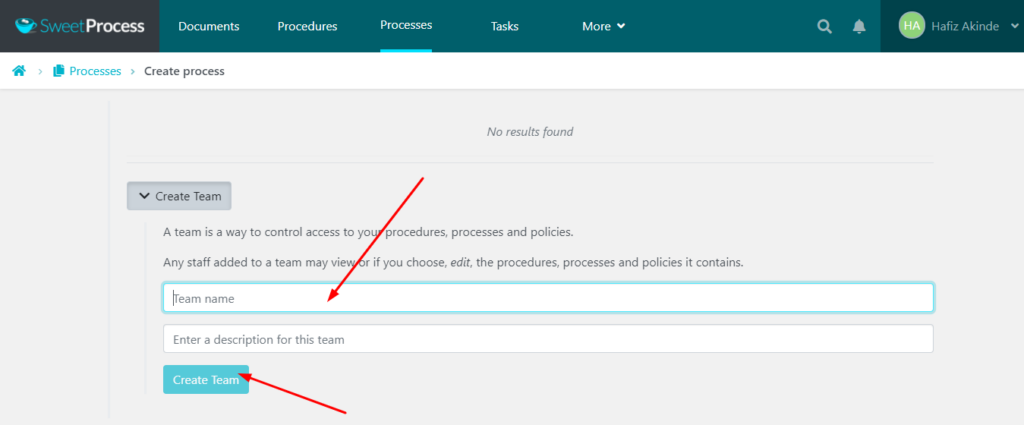
Step 7: The system will automatically check the new team you just created. You may then proceed to make your first process by clicking on “Continue.”
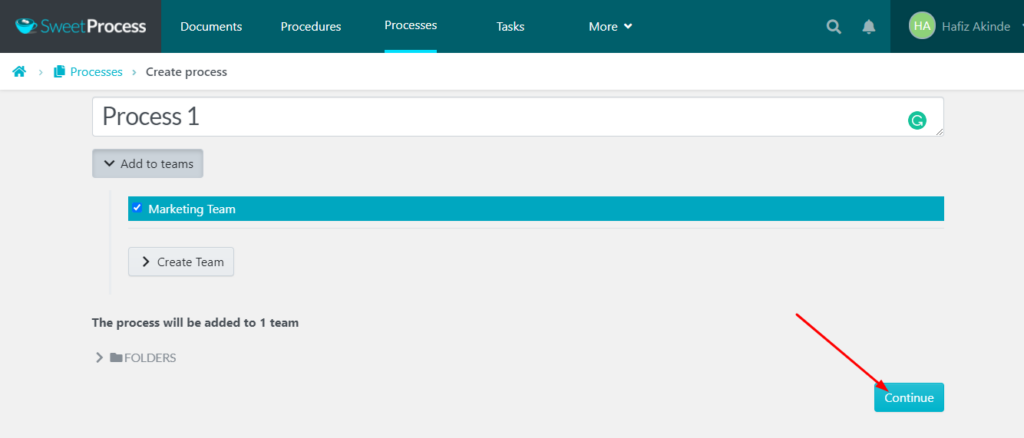
The process you just created will save directly to draft, and you must approve it to make it go live.
Step 8: Click on “Approve.”

There you are!
How to Assign Tasks to Team Members on SweetProcess
Follow the steps below to assign a procedure or process as a task to your employees.
Step 1: Navigate to the procedure or process you want to assign, then select the three-dot menu to the right of the procedure or process.

Step 2: Click the “Assign as Task” option from the drop-down option.
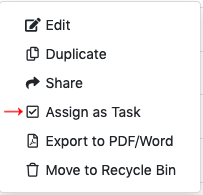
Note: you may also assign a task while looking at the procedure or process itself from the “Actions” menu on the top right of the screen.
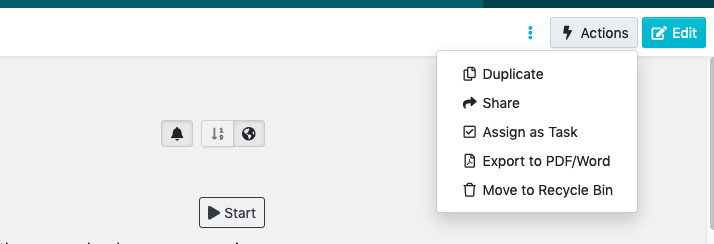
Step 3: Pick a single task for group collaboration or multiple tasks for individual assignments. Choose teammates individually or assign them to entire teams or specific roles. Their work will align based on your earlier choice, either collaborating as a team or managing separate tasks.

How to Create and Manage Policies on SweetProcess
Managing your policies is relatively straightforward. Here are a number of things to do to manage your policies.
1. Creating Policies With SweetProcess
Step 1: Click on the “Policies” tab.

Step 2: Once the page opens up, click on the “Create Policy” button on the top right-hand side of the page.

Step 3: Enter the title of the policy.

Step 4: Add the policy to a team or multiple teams. Click on a checkbox to add the policy to a team or on multiple checkboxes to add the policy to multiple teams at the same time.

Step 5: Click on the “Continue” button.

Step 6: Click on the space beneath the heading “Click here to edit policy content” to add relevant content to the policy. Once done, click on save changes to affect the change needed.

Step 7: As soon as you are done with documenting the policy, click on “Approve,” which is on the top right-hand corner of the page, to approve the policy and make it live.

Note: If you cannot approve the policy, you will be able to request approval by clicking on the “Request Approval” button, as shown below.

2. Importing a Policy Into SweetProcess
Step 1: Click on the “Policies” tab.

Step 2: Once the new page opens up, click on the down-arrow button to the right of the “Create Policy” button.

Step 3: After the menu appears, click on the “Upload document” button.

Step 4: After the “UPLOAD DOCUMENT” dialogue box opens up, click on the “Add to teams” button to add the policy to a team or multiple teams.
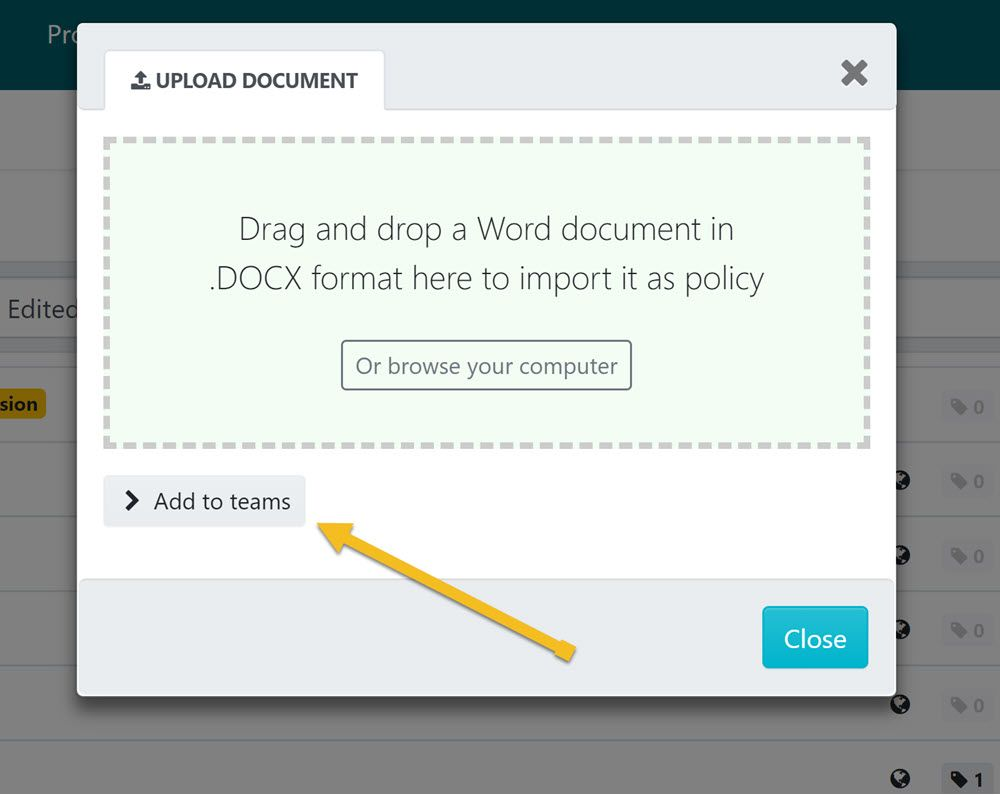
At this stage, the file will be processed and imported into SweetProcess.
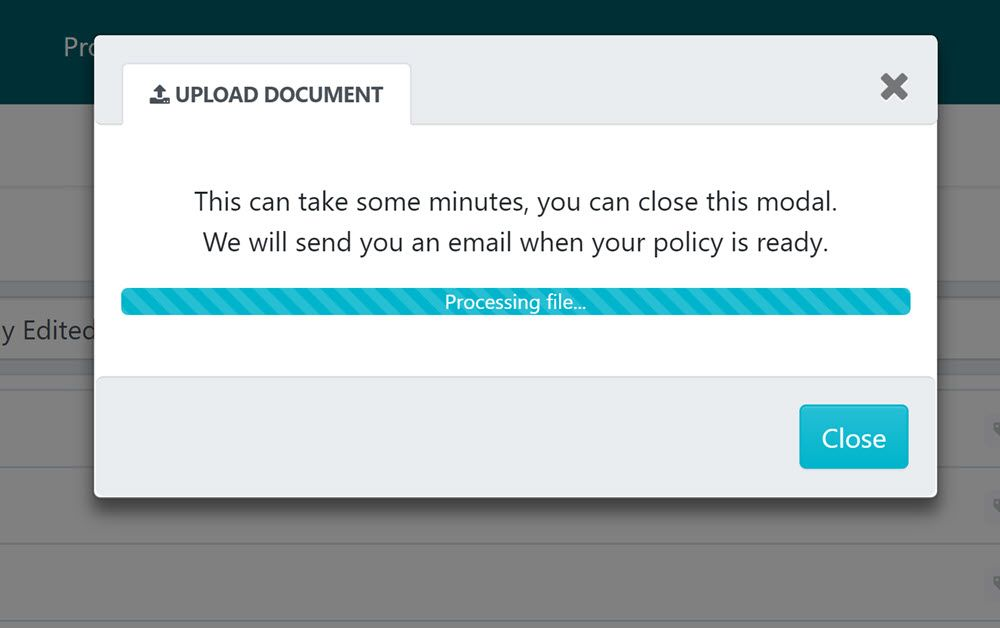
Step 5: After the policy has been imported, click on the “View policy” button.
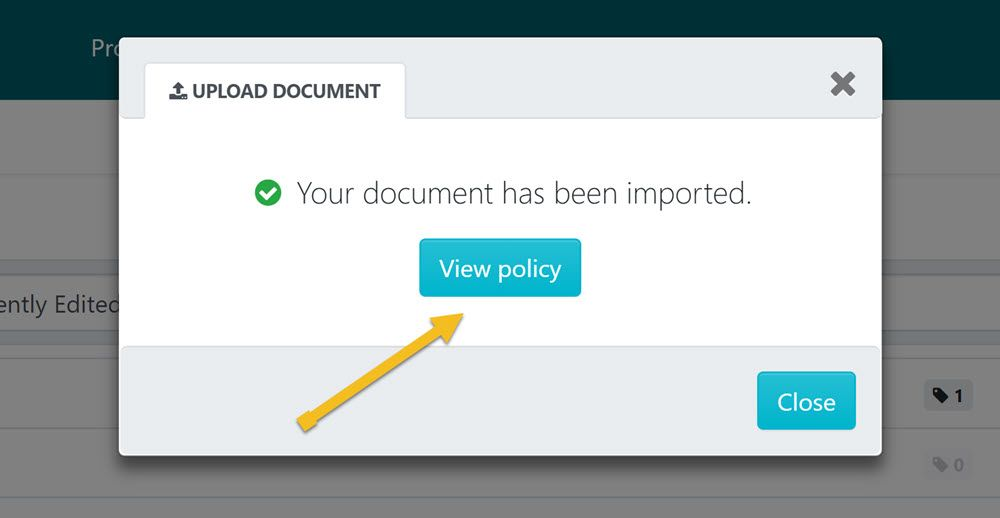
Step 6: Once the new page loads up, click the “Edit” button to make changes or improvements to the policy you just imported.

Step 7: Make all the necessary changes and improvements to the policy as needed.
Step 8: After making all necessary changes and improvements to the policy you imported into SweetProcess, click on “Approve,” which is on the top right-hand corner of the page, to approve the policy and make it live.

Step 9: Note: If you cannot approve the policy, you will be able to request approval by clicking on the “Request Approval” button as shown below.

3. Deleting a Policy in SweetProcess
Step 1: While editing a policy, click on the “Actions” menu, then select “Move to Recycle Bin” from the drop-down options.

Step 2: Confirm the delete action by clicking on the “Move to recycle bin” button.

Step 3: View the deleted policy and other deleted contents in the recycle bin by visiting https://www.sweetprocess.com/accounts/recycle/

Note: You may delete it permanently or restore it.
As you have seen, creating processes and procedures in SweetProcess is relatively easy. What’s more interesting is that you can go even faster by using SweetProcess’s artificial intelligence (SweetAI) to create a policy so you don’t have to start from scratch.
Try SweetProcess for free for 14 days to see if it suits your organization’s process and procedure creation needs. No credit cards are required.
Turning Existing Procedures and Policies Into a Knowledge Base for Your Employees or Clients
Step 1: Create your procedure or policy.
Step 2: Click on “More” and choose “Knowledge Bases” from the drop-down options.
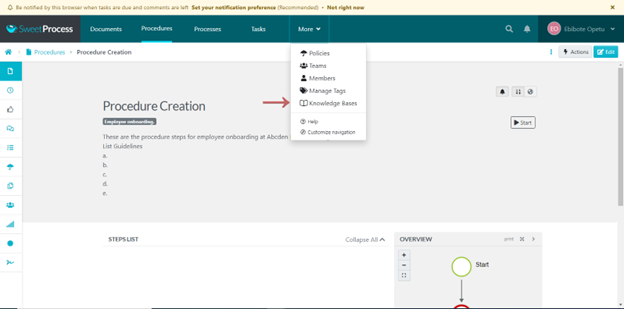
Step 3: Click on “Create Knowledge Base.”

Step 4: Input the knowledge base title.

Step 5: Create a category.

Step 6: Click on “Add New Article” to upload your preferred policy, document, or procedure into the knowledge base.

Step 7: Enable the knowledge by checking the box, then set the access level. Note: You can control who has access to the knowledge base: the general public or just members of your team.

A Customer’s Experience With Operational Excellence Using SweetProcess
Before attaining operational excellence, Zen Media, a PR firm, struggled with disorderly processes, leading to inconsistencies. Despite having business processes, the lack of structure led to employees creating their own methods, resulting in chaos and discrepancy for the public relations (PR) firm specializing in the tech niche.
Stephanie Chavez, the chief marketing officer, set out to enhance the company’s operational excellence by establishing a more structured workflow to attain shared objectives.
Stephanie emphasized, “Our products and client service were consistently excellent. That was never in question. What we deliberated on was ‘how can we simplify?”
SweetProcess became a pivotal element for their company, aligning their business operations with employees’ exceptional performances. It standardized its output, ensuring adequate quality checks, strengthening customer trust, and fostering operational excellence.
Stephanie acknowledged that using SweetProcess unifies everyone, ensuring greater efficiency and predictability.
Are you striving for operational excellence? Experience the business transformation with SweetProcess. Sign up now for a 14-day free trial to streamline your operations and achieve consistency in your workflows!
Top Operational Excellence Methodologies

Over time, many methods have emerged in business culture to achieve operational excellence. Let’s explore five prominent ones below.
Lean Manufacturing
Lean manufacturing concentrates on systematically identifying and eliminating waste in processes. Companies adopting this method focus on steps adding value while cutting out unnecessary ones. The objective? Cut costs by producing more with fewer materials.
Fundamental principles revolve around enhancing product/service quality, axing non-value-adding elements, and slashing overall expenses. Seven waste sources are identified below.
1. Mistakes: Errors disrupting smooth operations, leading to defective products.
2. Overproduction: Making items before necessary.
3. Over-processing: Including more steps than necessary, wasting time.
4. Transportation: Unnecessary movement of materials or finished products.
5. Motion: Unneeded movement of equipment or people.
6. Inventory: Supply surpasses demand, resulting in waste.
7. Waiting: Long employee waits for feedback or instructions, wasting time.
Six Sigma
Six Sigma is a systematic approach aiming to enhance quality and customer experience by minimizing production variations. Companies using this method strive for quality levels above 3.4 defects per million opportunities (DPMO).
Invented in 1986 by Bill Smith, a Motorola engineer, Six Sigma gained popularity among Fortune 500 companies. Today, around half of them have adopted Six Sigma to some extent.
It employs Deming’s DMAIC framework:
1. Define: Clarify the problem.
2. Measure: Use data to quantify and locate process areas needing improvement.
3. Analyze: Determine the problem’s cause with data.
4. Improve: Address the root cause, making necessary process changes.
5. Control: Ensure sustained process improvements.
Kaizen
The Kaizen methodology, originally for auto assembly lines, is now applied to various initiatives. Kaizen means “continuous improvement” in Japanese. It stresses consistent, minor enhancements at all levels within an organization.
It enhances quality, cost, delivery, operations management, safety, and other business facets. Kaizen asserts that regular, minor changes yield significant long-term results. It fosters innovation and teamwork, involving every employee in continual improvement.
Different from other methodologies, Kaizen emphasizes cultural improvement over tool usage. It complements methods like Six Sigma and 5S.
The Kaizen Institute bases its operational excellence on five principles:
1. Understand the customer for value creation.
2. Eliminate waste at every chance.
3. Drive change at the work level.
4. Embrace transparency and data.
5. Empower individuals.
Kanban
Kanban, an operational excellence method prevalent in manufacturing, visualizes production and inventory data in transparent displays. This technique highlights overproduction, underproduction, inventory shortages, and production disruptions.
Its aim? Align production with customer demand, slashing waste, overproduction, and inventory excess. Kanban serves as a workflow visualization tool, aiding teams, departments, and leadership in streamlining processes. It’s a pivotal part of lean process enhancement, driving efficiency and effectiveness.
David Anderson identified five vital elements of Kanban boards:
1. Visual signals: Color-coded cues or markers used to indicate status, urgency, or progress within the workflow.
2. Columns: Segmented sections on the Kanban board representing various stages or steps in the process flow.
3. Work-in-progress limits: Predetermined constraints on the number of tasks or items allowed in each workflow stage simultaneously, preventing overload and bottlenecks.
4. Commitment point: The stage at which work is committed to starting, ensuring resources aren’t allocated until necessary.
5. Delivery point: The final stage where completed work is moved out of the system, signaling its successful conclusion and freeing up resources for new tasks.
5S System
5S stands as a method of shaping workplaces into clean, tidy, safe, and well-organized spaces, cutting waste and boosting employee productivity. It’s crafted to foster a quality and standard work setting, both physically and mentally.
Derived from five Japanese “S” terms for visual control and lean production, 5S has these crucial pillars:
1. Seiri: Sort necessary tools, parts, and instructions, removing the unnecessary.
2. Seiton: Arrange and label parts and tools for easy use.
3. Seiso: Conduct regular cleanup efforts.
4. Seiketsu: Daily upkeep of the workspace.
5. Shitsuke: Instill the habit of consistently following the first four S’s.
Benefits of a lean 5S program include enhanced safety, increased equipment availability, lower defect rates, reduced costs, improved agility in production, better employee morale, optimal asset utilization, and a stronger enterprise image.
Operational Excellence Examples From Which You Can Learn

In this section, we’ll share some examples of operational excellence organizations can emulate from different industries. Whether improving manufacturing processes or refining marketing strategies, these examples show how operational excellence methods work universally and matter significantly.
1. Operational Excellence in Manufacturing: Toyota and Jabil as Case Study
Numerous manufacturing companies apply operational excellence to cut waste and create smoother, more predictable processes.
Toyota
In 1950, Toyota Motor Company faced near bankruptcy post–World War II, producing a mere 2,685 cars yearly compared to Ford’s 7,000 daily. Engineers Shigeo Shingo and Taiichi Ohno introduced lean manufacturing, allowing more car production with fewer resources—machines, people, space, time, and energy. Today, Toyota stands as a leading and profitable automobile manufacturer.
Jabil
Established in 1966 in Michigan, Jabil is the world’s third-largest electronics manufacturing services provider, boasting a fiscal 2016 revenue of 18.4 billion and 180,000 committed employees.
In a BTOES insights case study, Jeff Porada, Jabil’s global lean Six Sigma director, credits operational excellence for their 50+ years of profitable business. Strategic alignment and visual management engaged leadership, ensuring sustainability and fostering a vision for the next 50 years.
Porada emphasizes continuous transformation as crucial for survival in a competitive industry. He highlights that principles drive high-performance organizations, using tools to fortify adaptability and resilience without leading the charge.
2. Operational Excellence in Healthcare: SickKids as Case Study
Operational excellence in healthcare focuses on enabling staff to provide safe and reliable care, improving processes for efficient resource use, eliminating mistakes and unnecessary procedures, and enhancing health outcomes.
SickKids, a renowned children’s hospital in Toronto, embarked on its operational excellence journey in 2012 through a successful continuous improvement program.
Their approach involved a specialized team of five full-time staff, mainly from industrial engineering backgrounds, empowering employees to:
- Spot improvement opportunities.
- Craft efficient processes.
- Apply effective solutions.
The team provided training in the Daily Continuous Improvement Programme and process enhancement at the Yellow and Green belt levels.
“Organizations can only achieve true excellence when their employees are legitimately empowered. Implementing a lean management system is one powerful way to maximize the engagement of employees in organizational success.” —Jeff Mainland, executive VP, SickKids.
3. Operational Excellence in Real Estate: MonteVista Homes as Case Study
Construction work can get quite technical, so operational excellence in real estate often revolves around documenting and streamlining processes for high efficiency.
MonteVista Homes, which constructs quality, energy-efficient homes in Oregon, previously faced setbacks due to ineffective business process management and documentation.
In a SweetProcess interview, Luke Pickerill, MonteVista Homes’ president, shared: “We employ about 75 to 100 individual trade partners to get these homes built. Each trade partner may have anywhere between one to 40 employees. The most challenging part is the operational and organizational side of it. As one trade gets ahead of schedule or is late, that can affect all other buildings simultaneously.”
Transitioning to a more operationally efficient model with SweetProcess, MonteVista Homes resolved inconsistencies in processes and the safe work method statement. They now easily document and onboard in hours, allowing management to focus on enhancing customer satisfaction and driving revenue growth.
4. Operational Excellence in Marketing: Mudd Advertising as Case Study
Mudd Advertising, a top agency in the U.S. specializing in automotive advertising, has served over 3,000 accounts yearly for three decades.
In an interview, Dave Meindl, Mudd’s senior advisor for digital technology and performance, revealed their major challenge: a lack of existing systems. Processes were disorderly and undocumented. He explained:
“They had no system for keeping track of how things were done. I’m assuming it just sort of happened by word of mouth or something. As soon as I got there and saw that there was no way to keep track of these processes, I immediately said we needed to solve this problem; otherwise, there’s going to be complete chaos.”
Using SweetProcess for improved operations, Meindl achieved:
- Enhanced efficiency via proper documentation, reducing errors.
- Cost savings by streamlining processes and eliminating unnecessary steps.
- Ensured top-notch performance management with reference documents for employees.
- Accelerated onboarding and training, simplifying tasks for new hires.
You can learn more about SweetProcess or claim your 14-day free trial without any initial commitment—not even a credit card.
How to Measure Operational Excellence in Your Company

Assessing operational excellence is essential to understanding how effectively an organization operates. This signifies making sure that a company runs as smoothly and effectively as possible, delivering value to customers.
But how do you measure this? Here are some detailed tips:
1. Process Efficiency
The efficiency of a process can be checked by evaluating how well things are running by looking at how fast they are, how well they work, and how much they need to do their job. This can help you identify and fix existing problems without hassles.
2. Quality and Defect Rate
This involves monitoring the quality of products or services delivered, ensuring consistently high standards across all operations.
3. Financial Health (Cash Flow and Gross Margin)
Check to see if the organization has enough money to keep going. Financial health can be assessed by looking at things like cash flow and gross margin; these two metrics ensure the organization’s sustainability and profitability.
4. Customer Satisfaction
Find out how happy customers are by asking them what they think. Collect customer feedback to measure their satisfaction with your products or services. This can help you make sure that customers feel good about using the organization’s products or services.
5. Employee Engagement and Satisfaction
A practical approach involves asking employees how they feel about working for your organization. Survey employees to get an idea of their level of motivation and commitment or if they are happy with their work. The feedback you get can help you improve employee engagement, which significantly influences operational success.
6. Productivity
To know how productive your team is, you must analyze the organization’s output relative to its resources. This can help you find ways to make things run more smoothly.
How Operational Excellence Differs From Other Operations Frameworks

Operational excellence often gets confused with some business operations frameworks. While some of these frameworks may share some similarities in some parts, they usually differ in their approaches and objectives. These frameworks mainly aid operational efficiency.
However, operational excellence focuses on a broader, more comprehensive organizational transformation, encouraging a culture of relentless improvement and sustainable success. Let’s take a look at how operational excellence compares with some of these frameworks.
1. Operational Excellence vs. Continuous Improvement
Operational excellence and continuous improvement differ and yet aren’t entirely separate methods. Successful companies benefit from incorporating both in their operations.
Continuous improvement involves continuously enhancing current processes to minimize waste, improve quality, and maximize human potential. It’s an ongoing journey for maximum efficiency.
However, solely focusing on refining processes can limit innovation and diversification of revenue sources. This is where operational excellence becomes crucial.
Again, achieving operational excellence is essential for continual business growth and innovation. It ensures everyone knows their role, identifies issues, and corrects processes independently, reducing the need for constant managerial oversight.
Additionally, operational excellence frees leaders from daily task management, allowing them to concentrate on innovation and activities promoting revenue growth.
2. Operational Excellence vs. Process Excellence
Operational excellence, as opposed to process excellence, differs in its broader focus and scope.
Process excellence centers on perfecting a single process, focusing on one area to solve specific issues. On the other hand, operational excellence encompasses process excellence but widens its view to consider the connections between different processes.
Think of a bakery aiming for operational excellence across its operations. While process excellence improves individual baking steps, operational excellence goes beyond. It involves optimizing various functions like mixing, baking, packaging, and delivery.
After perfecting each stage, an operational excellence approach evaluates how these processes connect, share information, and identify potential redundancies or inefficiencies. It seeks to bridge gaps, break down barriers, and address challenges arising from integrating new technologies into the bakery’s production chain.
3. Operational Excellence vs. Operational Efficiency
Operational efficiency is about improving processes to save money and increase productivity. Think of a pizza delivery business: it focuses on making the delivery process faster and cheaper, like optimizing routes for efficiency.
Operational excellence, however, goes further than efficiency. In this pizza context, it involves ensuring consistent, delicious pizzas, exceptional service by the delivery staff, and continuous innovation to create a remarkable customer experience.
Both operational excellence and efficiency are crucial for business success. They are vital parts of running a business smoothly, encouraging improvement, customer focus, and aligning strategies. Understanding these distinctions helps companies elevate their operational performance and stand out in their industries.
The table below highlights the key differences between operational excellence and other frameworks that appear to be similar.
| Key Points | Operational Excellence | Continuous Improvement | Process Excellence | Operational Efficiency |
| Focus | Broad and comprehensive | Ongoing process enhancement | Perfecting single processes | Streamlining processes for efficiency |
| Attributes | Encourages innovation, customer-centricity, and strategic alignment | Continuous refinement for efficiency | Centers on improving specific processes | Focuses on cost saving and speed |
| Limitations | Emphasizes continual evolution, which may demand consistent adaptation | Overemphasis may limit diversification and innovation | May overlook broader organizational connections | Sole focus may inhibit innovation |
| Importance | Essential for sustained growth and innovation | Ensures ongoing enhancement | Enhances specific aspects of operations | Crucial for smooth and cost-effective processes |
Achieve Consistency in Your Company’s Operations Using SweetProcess
Achieving consistency in business is crucial to success. The pursuit of operational excellence isn’t just a choice; it’s a strategic, all-important necessity. To excel on this path, you must understand the core principles of operational excellence, the top operational excellence methodologies, and how to measure operational excellence in your company, which this article delivers.
So what’s the next step?
Let SweetProcess be your reliable companion in your journey toward operational excellence. Claim SweetProcess’s free 14-day trial to streamline your business processes, develop a culture of teamwork and continuous improvement, and position your organization for future success.
